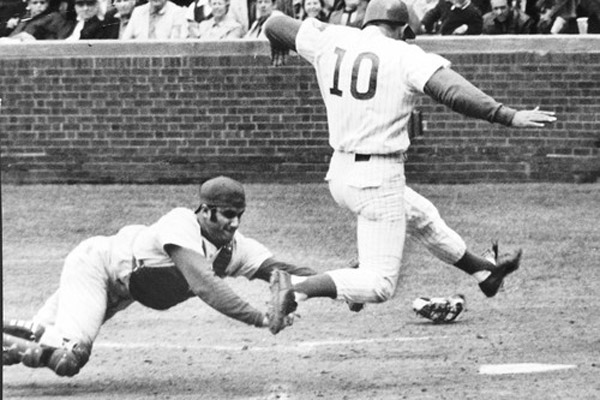
Ron Santo is finally in the Hall of Fame. It's too late for Santo, who died on December 3rd of last year, but it's wonderful news nonetheless that the Hall finally came around.
It's good, in part, because the notoriously crochety Hall voters are recognizing a player whose skills—though obviously appreciated and beloved in his career—are considered even more valuable today than they were in the 1960s and 1970s. For instance, take a look at his page on Baseball Reference, particularly the leaderboards, which tell the story of how Santo was underappreciated for so long.
By the usual sexy, back-of-the-baseball-card stats, Santo was very good, but not extraordinary. Santo finished near the top only three times in batting average, coming in 7th, 9th, and 10th. He finished 3rd in home runs once and 4th once, but was usually around 6th to 8th. In hits, Santo finished 7th, 10th, 10th, and 9th in the years he was near the top of the charts.
But Santo had a great eye, finishing first in walks four times in his career. As a result, he led the league in times on base percentage three times. He also led the league in sac flies three times, and finished high in runs created four times (2nd, 4th, 2nd, and 3rd).
Santo was an even better fielder. In his career as an everyday third baseman, he finished first in range factor per nine innings five times in his career, and was never lower than 4th; he led the league in assists seven straight seasons, and putouts seven out of eight years between 1962 and 1969.
There aren't many third basemen in the Hall of Fame; fewer still played during years easily comparable to those Santo played in. Via Fangraphs, here's a look at cumulative WAR (Wins over Replacement Player, a stat designed to measure how much better a player is than a MLB-ready minor leaguer or easily signable free agent) among the HoF third basemen who played during or after Santo's time, though Paul Molitor, who was a designated hitter for much of his career, is arguably out of place.
Source: FanGraphs — Wade Boggs, George Brett, Paul Molitor
In short, Santo was arguably better over time than his peers, even the great Brooks Robinson. By Baseball Prospectus's numbers, Santo had two MVP-caliber years and finished just shy twice, despite never winning the award (a longtime knock on Santo's candidacy). Only Mike Schmidt passed Santo before Santo's health issues ended his career several years before a player of his caliber and position would usually retire. Which brings up the point that diabetes, at the time, was not well understood or treated; the usual comparison between yesterday's players and today's in the context of superior conditioning and training—pitchers pre- and post-Tommy John surgery, for instance—is only more dramatic in Santo's case. Santo self-medicated with candy bars between innings, gauging his need based on his mood, a far cry from the technology available to today's players.
It's not just that Santo was underappreciated as a player, it's that a player of Santo's type was underappreciated until recently. He was a brilliant defensive third baseman, and for all his obvious skills as a hitter, his real offensive value was hidden in stats that baseball teams and nerds have only started to emphasize in recent years. As Robert Kurson wrote in 2002:
"He surely should be in the Hall of Fame," says Barry Codell, a Chicago baseball statistician and creator of several innovative statistics for the sport. "It was incumbent upon the baseball writers to put him in and they blew it. He should have been a first-ballot choice, an obvious choice."
In making the case for Santo, Codell points to aspects of a career most writers never consider. He notes, for example, that while Santo was slow afoot, he once led the league in triples, "indicative of his all-out style of play." He remembers Santo as a "great" walker who could coax ball four from the best control pitchers, and a fiercely competitive player. And he invokes Santo's effect on the Cubs: Since Santo left the team, almost 30 years ago, the Cubs haven't had consecutive winning seasons. (They had six of them with Santo, from 1967 to 1972.) Before Santo arrived, in 1960, the Cubs hadn't posted a winning record in 13 seasons.
Codell thinks Santo has been overlooked for a few reasons. First, while he was a great fielder, he was less spectacular in execution than his contemporary Brooks Robinson, the Orioles Hall of Famer. (Offensively, though, Santo trumps Robinson: He hit for a higher average, .277 versus .267, slammed more home runs, 342 versus 268, and knocked in about the same number of runs, 1,331 versus 1,357, all in a career eight years shorter than Robinson's.)
Second, baseball writers already have voted in three of Santo's teammates-Ernie Banks, Billy Williams, and Ferguson Jenkins-"and they might be reticent to vote for a fourth from a Cubs team that never got closer to winning the division than eight games out." Finally, Hall of Famers Eddie Mathews and Robinson "were the third basemen of the era in terms of publicity."
"Sometimes an era gets a guy in, like [Cubs second baseman] Johnny Evers in his limited era," Codell says. "But Santo's impact has stood up over time."
It's a good day for Santo's family and for Cubs fans, but it's also good for baseball fans in general, and how we appreciate the game.



